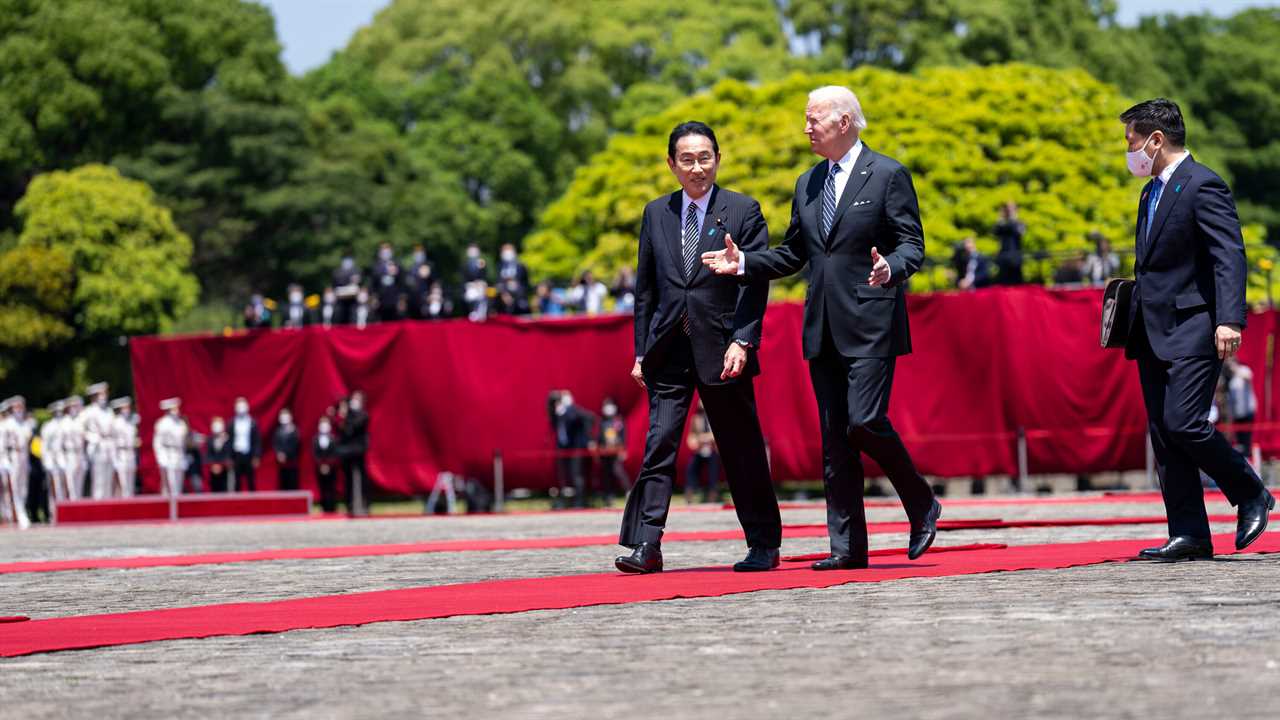
TOKYO — President Bidenhas enlisted a dozen Asia-Pacific nations to join a new loosely defined economic bloc meant to counter China’s dominance and reassert American influence in the region five years after his predecessor withdrew the United States from a sweeping trade accord that it had negotiated itself.The alliance will bring the United States together with such regional powerhouses as Japan, South Korea and India to establish new rules of commerce in the fastest-growing part of the world and offer an alternative to Beijing’s leadership. But wary of liberal opposition at home, Mr. Biden’s new partnership will avoid the market access provisions of traditional trade deals, raising questions about how meaningful it will be. “We’re writing the new rules for the 21st-century economy,” Mr. Biden said on Monday in Tokyo during the launch for what he has termed the Indo-Pacific Economic Framework. “We’re going to help all of our country’s economies grow faster and fairer.”The president sat alongside Prime Minister Narendra Modi of India and Prime Fumio Kishida of Japan for the rollout of the initiative, while other leaders joined the event by videoconference. The new alliance represents the centerpiece not only of Mr. Biden’s first trip as president to Asia but also of his broader strategy in the region at a time when China has increasingly filled the void left when President Donald J. Trump pulled the United States out of the Trans-Pacific Partnership in 2017.“It is by any account the most significant international economic engagement that the United States has ever had in this region,” Commerce Secretary Gina M. Raimondo, who will lead some of the negotiations triggered by the agreement, told reporters on Sunday. “And the launch of it tomorrow here in Tokyo marks an important turning point in restoring U.S. economic leadership in the region and presenting Indo-Pacific countries an alternative to China’s approach to these critical issues.”In addition to the United States, India, Japan and South Korea, the 13 members of the framework will include Australia, Brunei, Indonesia, Malaysia, New Zealand, the Philippines, Singapore, Thailand and Vietnam. Together, the participating nations represent about 40 percent of the world economy, and any specific agreements that emerge from the grouping could go a long way toward setting standards even beyond its membership.ImageA map of the Korean border behind Mr. Biden at Osan Air Base in Pyeongtaek, South Korea, on Sunday.Credit...Doug Mills/The New York TimesAmid uncertainty and skepticism in the region about what the new framework would actually mean, American officials scrambled in recent weeks to line up enough major countries to commit in hopes of making a big impression with a splashy kickoff. Privately, they said all of the nations they had been seriously targeting agreed to join, but some analysts wondered whether any assurances or trade-offs proffered to entice participation would diminish the scope of the new bloc.The new Biden initiative comes less than five months after the China-led Regional Comprehensive Economic Partnership officially went into force, linking 15 Asia-Pacific economies in the world’s largest trade bloc. Most of the countries Mr. Biden signed up for his framework already belong to the bloc with China.For the United States, the new framework effectively replaces the more expansive Trans-Pacific Partnership as the main vehicle to shape the flow of goods and services in the region. President Barack Obama, with Mr. Biden as his vice president, negotiated the T.P.P., only to have Mr. Trump abandon it on his first full weekday in office, leaving the bloc to proceed without its largest member.But rather than simply rejoin the partnership, as Japan, Singapore and other countries wanted him to do, Mr. Biden essentially abandoned it too, in deference to opposition within his own party. To assuage his liberal base, the new framework, unlike T.P.P. and other traditional free trade pacts, will not reduce tariffs.Business executives say the China-led bloc has now done more to define trade in the region, even though it asks little of its members and focuses mainly on limiting red tape. The American vision for the region, in contrast, is ambitious, aiming to raise labor and environmental standards. But without offering more access to its market, analysts say, the United States does not have a lot of carrots to encourage those changes.“It is going to be difficult to convince Asian governments to change rules in ways that may be disruptive to their political economies without the promise of increased access to the American market,” said Aaron Connelly, a research fellow at the International Institute for Strategic Studies in Singapore.ImageDemonstraters in Tokyo on Sunday protesting againstBy: Peter Baker and Zolan Kanno-Youngs
Title: Biden to Begin New Asia-Pacific Economic Bloc With a Dozen Allies
Sourced From: www.nytimes.com/2022/05/23/world/asia/biden-asian-pacific-bloc.html
Published Date: Mon, 23 May 2022 10:54:57 +0000
Read More
 UK PoliticsWorld PoliticsVideosPrivacy PolicyTerms And Conditions
UK PoliticsWorld PoliticsVideosPrivacy PolicyTerms And Conditions
